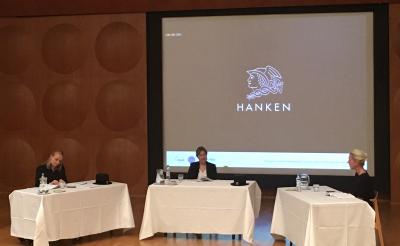Let me tell you a story!
Opponent Sara Rosengren, Custos Veronica Liljander and Eeva Solja in the public examination of her thesis, in the assembly hall at Hanken.
“Storytelling in various marketing contexts has been a trend lately“, says M.Sc. (econ.) Eeva Solja who defended her thesis Let me tell you a story. Consumer responses to company-created brand stories on Friday, 15th October, 2017, at Hanken School of Economics in Helsinki. Solja continues that brand stories encompass a wide array of stories, not only the perhaps most typical story type about a company’s history. “No, there are plenty of different story types and contexts for transmitting them. For instance the ice-cream brand Ben and Jerry’s has short, funny stories on its ice-cream packages. Stories are also told on for instance price tags and web pages.”
Stories have been the subject of research within the field of marketing. However, most of this research is conducted in an advertising context. We hence know something about how advertising stories impact consumers’ brand responses, but there is a paucity of studies on how stories work in other key marketing contexts, such as product packages and price promotion.
What is a story then? “A story, in its simplest form, is a product of cause and effect, temporality, and characters”, explains Solja. Stories can be long, or they can be very short, under one hundred words. That is how she defined a short brand story in her research. But how can you tell a whole story in so few words? “Consumers can use their previous story experience when perceiving a new short story. Most of us are familiar with some universal story lines, such as the Cinderella story”, says Solja and adds, “You don’t have to write down the whole story for consumers to recognize it.” But all stories are not good stories. Solja says that it is of course important that the story the company uses fits in the brand and its values.
What was surprising in Solja’s research was that the story context was very significant. An emotional story worked well in an advertisement but not on a product package. She interprets the result so that people have a different mindset when reading a package: Consumers are used to information intensive packaging texts, which means that an emotional story is perceived as atypical, or out of place. Advertisements, on the other hand, are expected to be more emotionally charged. “When reading a story our brain processes the information in a narrative manner. The narrative mode of thought can evolve to absorption, a state characterized by focused immersion, involvement, and detachment from the surrounding environment, like when reading a good novel, or watching a movie. That may also happen when reading a brand story on a product package, and it can be very persuasive.”
Before her research career, Solja worked in the B2C cosmetic and hygiene business for almost a decade, and found academic work as a welcome change, but very different from business practice. “I like the academic freedom combined with the responsibility of working independently and mostly alone. The pace in academia in general is much slower than in business and it is less dynamic. Nevertheless, I have learned a lot about myself, how I work and what motivates me.”



